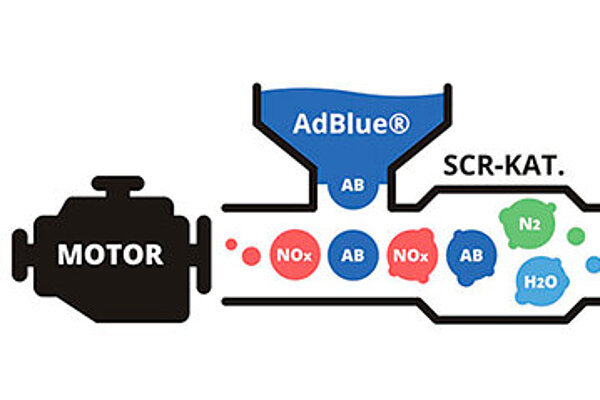AdBlue – a cleaning agent with no residual alcohol
Year of publication: 2023
It goes without saying that the idea of 32.5% urea in one litre of fluid doesn’t sound appealing. AdBlue is produced
purely industrially while human urine, on the other hand, is anything but clean. It contains 3-4% urea,
protein, other impurities – and often, residual alcohol, too.

Table of contents
Lower emissions and lower diesel consumption
However, it was precisely because of the sanitary connotations that the name AdBlue came into being. In principle, the name AdGreen would be a better description for the role of the concentrate. After all, AdBlue is key to reducing NOx emissions in the commercial vehicle sector and in diesel cars. The urea injected into the exhaust dissolves into ammonia and very small quantities of carbon dioxide (CO2) in the hot exhaust gas. The ammonia forms a compound with nitrogen oxides in the catalytic converter when exposed to heat. This produces nitrogen and water vapour, both natural components of the atmosphere and therefore completely harmless in the exhaust gas. This reaction is known as selective catalytic reduction (SCR). For vehicles, the urea solution is the storage or transport form for ammonia, which can also be used directly to reduce NOx in the SCR catalytic converter in stationary systems.
Using this technology offers a way to reduce pollutants in diesel engines, which ’suffer’ from the NOx particle trade-off due to combustion. Depending on the design, the engine generates either more NOx and fewer tiny soot (particles), or less NOx and more soot (particles). Both require an effective after-treatment process for exhaust gases. While the requirements of the Euro 5 emissions standard could still be fulfilled using internal engine measures (such as recirculating exhaust gases) and a diesel particulate filter, the emissions standard requires the use of an SCR system with AdBlue from Euro 6 onwards. Using an SCR system with AdBlue means that engines can be used differently, the soot quantity can be reduced over the entire operating range, the load points can be improved and, in addition to reducing NOx, fuel savings of up to 6 % can be achieved.
This technology reduces the nitrogen oxides in the diesel exhaust gases emitted by commercial vehicles by 85 % for Euro 5 and by 95-98 % for Euro 6 – and that’s all down to an AdBlue system. If a vehicle is equipped with such a system, however, it won’t run without AdBlue, as the engine won’t start if AdBlue is not present. And there is also a fiscal reason for this, too, as incorrect exhaust gas after-treatment would constitute tax evasion.
Demand for AdBlue has soared to extreme levels. Whereas a diesel car consumes only 1.5 to 2.8 litres every 1,000 kilometres, a commercial vehicle requires around 5 % – and large engines even up to 10% – of the diesel requirement in AdBlue. This equates to an estimated total consumption of AdBlue of between 2.5 and 5 million litres per day in Germany alone.
Characteristics at a glance
AdBlue is a registered trademark of the German Association of the Automobile Industry (VDA (Verband der Automobilindustrie e.V.)). Outside Germany, designations such as DEF (Diesel Exhaust Fluid) and AUS 32 (Aqueous Urea Solution) are also used.
The quality requirements for the product are set out in ISO Standard 22241-1. The pure urea content must be 32.5%. A higher concentration of 40 % (AUS 40) is required pursuant to ISO Standard 18611 for use in the large engine sector (marine or engine power plants).
Substances other than pure water and dyes are not permitted in AdBlue. Elements such as calcium and aluminium may only be present in very small traces. Under no circumstances may AdBlue be contaminated with non-ferrous metals such as zinc, copper or nickel, or elements such as sulphur, sodium or potassium. SCR catalytic converters are sensitive to what are known as catalyst poisons, and contaminated AdBlue significantly reduces a catalytic converter’s service life.
The transparent liquid is non-flammable and non-toxic, but may irritate the eyes, skin and respiratory tract. You should therefore rinse your skin under plenty of water if it comes into contact with AdBlue. Furthermore, AdBlue is corrosive to steel, iron, nickel and non-ferrous metals, while paints and plastics can be damaged by prolonged exposure.
Shelf life and storage
AdBlue’s shelf life depends primarily on the temperature and the circumstances in which it is stored. AdBlue can be stored for around 18 months at a storage temperature of -5 °C to +25 °C. It should be noted, however, that prolonged storage above 25 °C may cause the urea to decompose. If AdBlue is stored at temperatures above 30 °C, its shelf life is significantly reduced.
The following apply as a general rule of thumb: The storage stability decreases by six months for every 5 °C over 30 °C. If the product is still used at some point, this may result in damage to the catalytic converter system and the engine.
AdBlue freezes from -11 °C, but can be used once it has thawed out. A word of caution, though: AdBlue expands like water in frosty conditions and may cause containers to burst.
In principle, AdBlue should be kept out of direct sunlight and not stored at extreme temperatures. The containers must be well sealed to prevent dirt from penetrating and prevent the product from concentrating due to evaporation.
OELCHECKER Winter 2022, page 7



